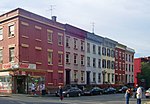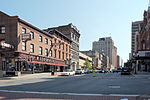Pastures Historic District

The Pastures Historic District is a residential neighborhood located south of downtown Albany, New York, United States. Its 17 acres (6.9 ha) include all or part of a 13-block area. It was originally an area set aside as communal pasture by Albany's city council in the late 17th century and deeded to the Dutch Reformed Church. As the city began to grow following its designation as New York's state capital a century later, it was subdivided into building lots, some of which were developed with small rowhouses. Many open areas remain today, and the houses have not been significantly altered. In 1972 the city designated it as a historic district and it was listed on the National Register of Historic Places. All but two buildings in the district are considered historic. One of Albany's busiest neighborhoods in the 19th century, the area fell into decline during the third quarter of the 20th as citizens left the city for the suburbs. Instead of the wholesale demolition of that era's urban renewal programs, the city government attempted to preserve and revitalize the area, evacuating the residents for years and demolishing some properties, a move that has been criticized as destroying the neighborhood as a standard urban renewal project would have. A recent mortgage fraud scandal has affected the neighborhood also, but it has once again become a diverse, fully occupied neighborhood.
Excerpt from the Wikipedia article Pastures Historic District (License: CC BY-SA 3.0, Authors, Images).Pastures Historic District
Westerlo Street, City of Albany
Geographical coordinates (GPS) Address Nearby Places Show on map
Geographical coordinates (GPS)
| Latitude | Longitude |
|---|---|
| N 42.643611111111 ° | E -73.754166666667 ° |
Address
Westerlo Street 51
12202 City of Albany
New York, United States
Open on Google Maps






